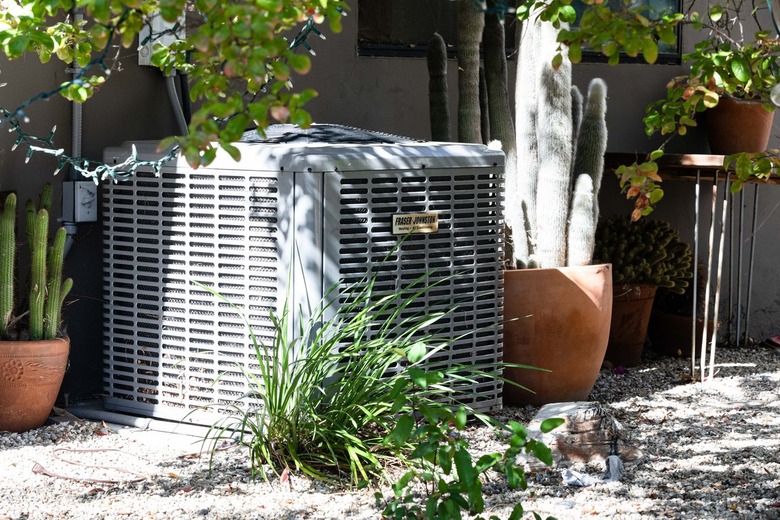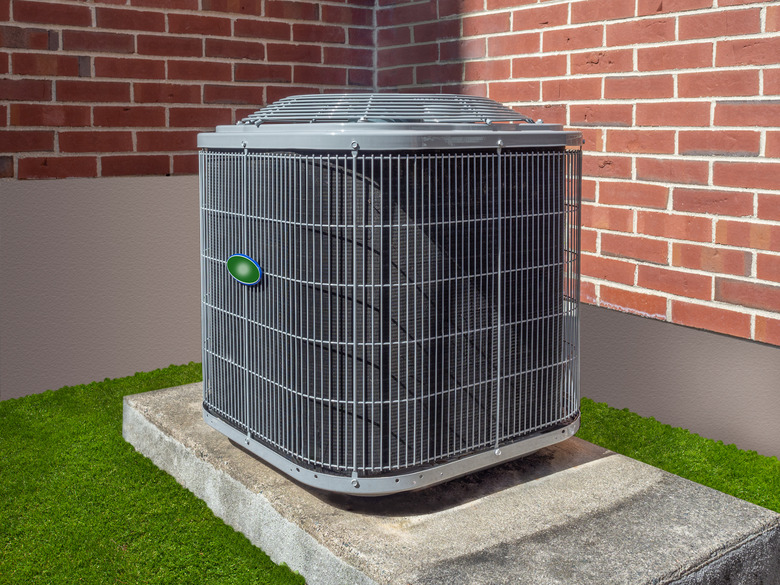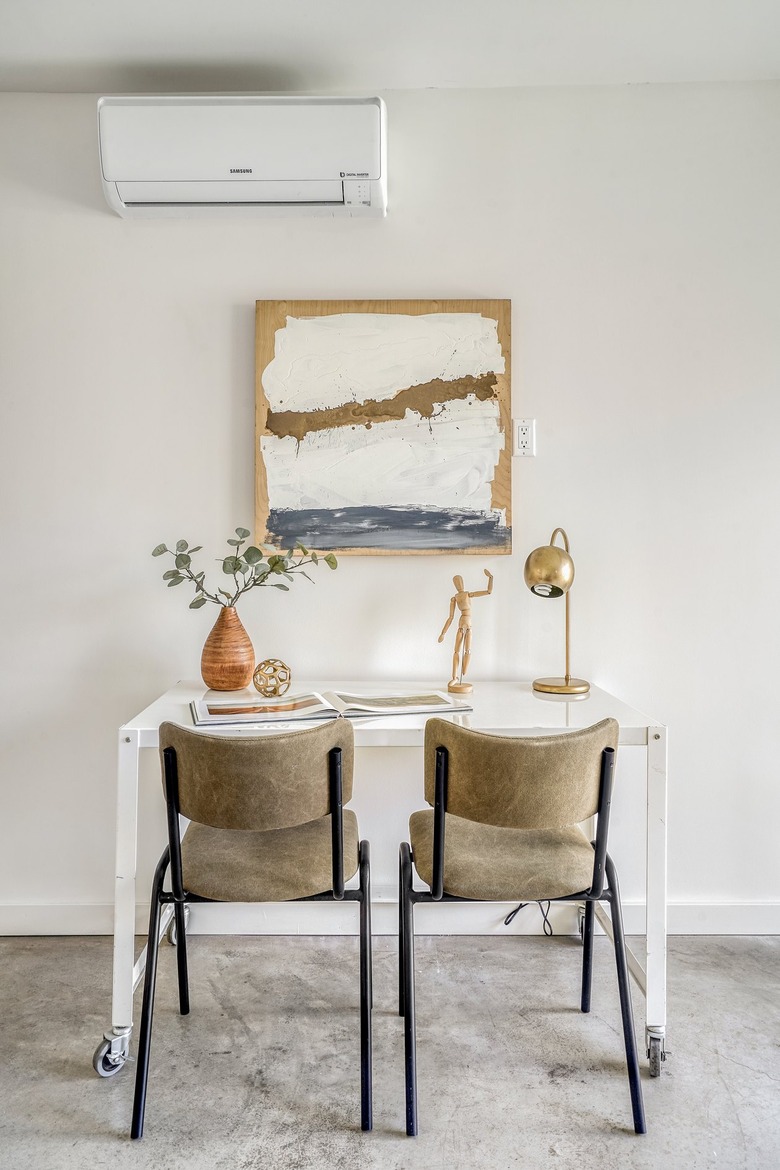Here's The True Cost Of Adding Central Air
We may receive a commission on purchases made from links.
If you've ever lived without central air conditioning — and suffered through a sweltering summer — you've likely wondered how much it actually costs to install a system (and finally ditch your window unit once and for all). But the hard truth is that the cost can vary widely.
The cost of installing central air conditioning in an average-size house (1,500 to 2,000 square feet) can be as little as $4,000 and as much as $15,000. Why such a wide range? It's because there are so many variables, including the actual size of the house, whether it has existing ductwork that can handle the new AC unit and the quality of the unit you choose. The HVAC contractor you choose to do the installation also factors into the equation, given that a fair amount of labor is involved, and not all contractors charge the same rate.
Adding New Ductwork Increases the Budget
Adding New Ductwork Increases the Budget
Installing a central air conditioner makes the most sense if you already have an HVAC system with existing ductwork (or passages that heat and air travel through in your home). The installers may have to make some modifications, such as increasing the size of the registers and installing a larger blower that provides enough airflow to prevent the AC coils from freezing. But no matter what upgrades are necessary, they'll cost a lot less than installing all-new ductwork. If you have to go that route, you're looking at an extra $3,000 to $10,000 to the total cost of the job.
If your home has a hydronic heating system and you're happy with it, you might balk at the idea of adding ducts for a forced-air cooling system. In that case, a ductless mini-split system consisting of an outdoor unit and an indoor wall-mounted unit might be for you. Installing new ducts might make sense if the radiant heat isn't keeping you warm, though, because you can alter the heating system with a heat pump that doubles as a central air conditioning system.
Higher SEER Ratings Equal Higher Costs
Higher SEER Ratings Equal Higher Costs
The most common configuration for an AC unit is a split system, in which the evaporator coils and air handler are located indoors, the compressor and condenser coils are in a separate unit outside and refrigerant passes between them through tubing that goes through a wall. This is also the least expensive option, costing between $2,500 and $7,000 depending on the seasonal energy efficiency rating (SEER) and size, which can be measured in British thermal units (BTUs) but more often in tons, where 1 ton is equal to 12,000 BTU hours. Packaged units that include the compressor, condenser coils and evaporator coils in a single housing are less common and slightly more expensive ($3,000 to $8,000), but if you want to mount the central AC on the roof, this is what you need.
It's up to homeowners to choose the SEER rating they want, keeping in mind that higher SEER ratings mean higher energy efficiency and higher upfront costs. A 13 SEER unit costs from $1,500 to $3,000, while a 24 SEER unit costs from $5,000 to $7,000. Homeowners in moderate climates can usually get by with a 14 or 15 SEER unit ($1,500 to $4,000), while those in hot climates are better off with an 18 or 19 SEER unit ($2,500 to $6,000) or better.
It isn't always cost-effective to choose a model with a high SEER rating because many older homes have enough air leakage to offset the dip in energy bills a high-efficiency model makes possible. The minimum allowable SEER, which is regulated by the Department of Energy, depends on where you live. It's 13 in more northerly, cooler climates, but it's 14 in the South and Southwest, and if you live there, you probably won't even be able to find a SEER 13 unit.
Sizing an AC Unit for Size and Location
Sizing an AC Unit for Size and Location
Tonnage is based in part on the size of your house and should be neither too small (or the house won't get cool) nor too large (which wastes energy and affects system performance), so it isn't really a variable. It usually takes a home energy audit or a Manual J load calculation — a technical term for measuring a home's heating and cooling needs — to determine the proper tonnage needed for a particular home.
This calculation is typically done by an HVAC contractor as part of an installation package, and it involves measuring the square footage and amount of heat the building gains and loses during the day. An independent energy audit can cost several hundred dollars, so this is a valuable extra, and if you're working with a contractor who doesn't think a Manual J load calculation is necessary, the Air Conditioning Contractors of America (ACCA) recommends finding another contractor.
The size of a central air conditioning unit also depends on where you live. A 3-ton unit, for example, can cool a 1,600- to 2,100-square-foot house in the North, but in the extreme South, it can only handle a home that is 1,500 to 1,800 square feet in total area. A 3.5-ton unit would be needed for a 2,000-square-foot house in the South. The difference in cost between a 3-ton unit and a 3.5-ton unit is about $630. In general, prices range from $2,000 for a 1.5-ton unit, which is the smallest available, to $3,690 for a 5-ton unit, which is the largest.
How Central Air Conditioning Ductwork is Calculated
How Central Air Conditioning Ductwork is Calculated
HVAC installers charge for ductwork in one of two ways: by linear foot and by duct. You can generally expect to be charged by the linear foot for a new installation, but if you're upgrading existing ductwork and only need a few modifications, you might be charged by the duct. The average cost per linear foot is $35 to $55, and per duct, it's $150 to $250.
Installing new ductwork in an existing home, as opposed to new construction, involves a lot of work. Wall coverings may have to be removed so that ducts can be installed, and the coverings need to be replaced afterward. That could involve extra contractors to do the drywall and painting work, although modern flexible ducts can often be installed without disturbing the wall covering. Ductwork has to be sized correctly for the system, and registers also have to be sized and placed to optimize airflow throughout the house. In total, the cost for new ductwork can be anywhere between $3,000 and $10,000 depending on:
- Number of stories in the building
- Duct material
- Locations of the ducts
- Number of vents
- Number of temperature zones
If you have an existing HVAC system, installing central air conditioning may still involve a fair amount of ductwork. Some of the existing ducts may have to be replaced with larger ones to accommodate the increased airflow, registers may also have to be enlarged and any leaks in the existing ductwork will have to be sealed. On average, this type of work can cost anywhere from $1,000 to $3,000.
Some Possible Extra Costs
Some Possible Extra Costs
Some central air conditioning units cost more than others. Five brands earned an excellent rating from Consumer Reports based on customer satisfaction —Trane, American Standard, Bryant, Lennox and Carrier — but they don't all cost the same. If you have brand loyalty to one of these manufacturers, you might have to pay extra for it, particularly if you choose Carrier, which tends to be the most expensive brand. Some other brands, including York and Goodman, are considerably less expensive, but Consumer Reports doesn't rate them as highly or, as in the case of York, doesn't recommend them at all.
Installing a new central air system in an older home may overload the home's service panel, or circuit breaker box, and replacing it with a larger one is another possibly unforeseen expense. You'll need a licensed electrician to do the work, and the typical cost to upgrade a 100-amp service panel to a 200-amp one is between $1,200 and $1,800 if everything goes smoothly. If there are problems, the cost could be as high as $3,000. That kind of an upgrade may make sense if you're in the middle of a major home improvement project, but it's a lot to spend if you're otherwise satisfied with your electrical service and you're doing the upgrade just to accommodate a new AC system.
Another problem with older houses is that they aren't sealed properly and don't have enough insulation, and that can make energy bills spike during hot summers when the air conditioner has to work double-time to maintain a cool temperature. It's difficult to estimate the extra cost to reseal and insulate because it varies from case to case, but in most cases, it would be from $1,000 to $2,000, and it's money well spent because it will also lower heating bills in the winter.
Alternatives to Central Air Conditioning
Alternatives to Central Air Conditioning
After figuring the total cost of installing an air conditioning system, you may decide that you can't afford it, but don't worry — that doesn't mean you have to endure the sizzling summer by staying in the basement. You have other options, especially if you live in a region that gets hot, dry weather, where a swamp cooler can take the place of a central air system.
A swamp cooler, otherwise known as an evaporative cooler, uses water evaporation to cool the air, and because it humidifies instead of drying out the air like an AC system, it's perfect for dry climates. Units can be mounted on the roof or on the ground outside the home, and although they require ductwork, it isn't as extensive or expensive as air conditioning ductwork. Swamp coolers also use less electricity than conventional central AC, so they're cheaper to run.
Ductless mini-splits offer another alternative to central air. A typical system includes a single compressor that lives outside and one or more (up to eight) indoor air handler units, or zones, each controlled by a separate thermostat. Instead of ducts, these units are connected by refrigeration tubing, which is much easier to install and better suited to a home that doesn't have existing ductwork. Besides keeping down installation costs, a ductless system, with a typical SEER rating of 22.5, is more energy efficient than a central AC system.
Neither swamp coolers nor ductless systems are free, but considering that it could cost as much as $15,000 to install central air conditioning in a house with no existing ductwork, they are cost-saving alternatives. A highly efficient 22.5 SEER, 3-ton quad-zone ductless system that includes a heat pump for winter heating can be had for around $4,000, and installation typically costs less than $2,000. A roof-mounted swamp cooler with a coverage area of 2,400 square feet, on the other hand, costs a measly $600, and installation shouldn't cost any more than $2,000. The most economical choices for homeowners on tight budgets are portable air conditioners and swamp coolers. Whether you choose a window unit or a standalone model that sits on the floor, no professional installation is required at all.
References
- Fixr: How Much Does It Cost to Install Central Air Conditioning?
- HVAC Direct: Proper System Sizing
- Carrier: Budgeting for HVAC: How Much Does Ductwork Installation Cost?
- Consumer Reports: Most Reliable Central Air Conditioning Systems
- Modernize: How Much Does an AC Unit Cost to Install?
- Angi: How Much Does It Cost to Install a Ductless Mini-split AC?


